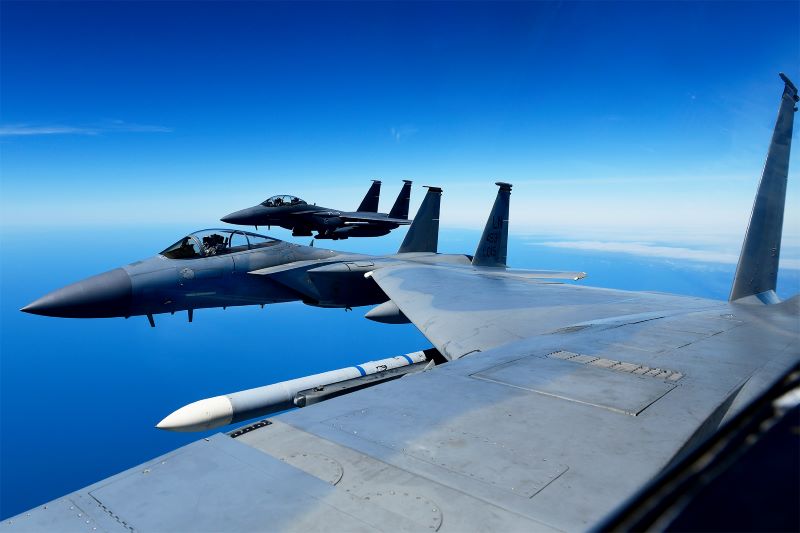
Combined Environments MIL-STD-810 Method 520 is used to evaluate the synergistic effects of multiple environmental stressors on equipment intended airborne applications. The use of synergetic effects can uncover failures effecting the safety, performance, or integrity of equipment under test that individual stresses would not reveal.
Environmental factors that are applicable to this method are vibration, temperature, humidity, and altitude. Fluctuations in input electrical power were added to this list in revision H of the military standard. These fluctuations include variations in voltage and frequency in addition to expected power transients. Additionally, revision H changed the title of this method from Temperature, Humidity, Vibration, and Altitude to Combined Environments.
Special Considerations When Applying Method 520
The United States Department of Defense originally used this multi-stress analysis approach in the development of the F-15 Eagle. While its primary application is for rotor and fixed wing platforms, it is also applicable for equipment destined for other platforms. Regardless of platform type, test tailoring is essential in creating test procedures. This tailoring should be based on the test item’s Life Cycle Environmental Profile (LCEP).
Performance of this method does not remove requirements for separate testing of each environmental stress included in this method. This method is not intended to include short duration, infrequent dynamic effects such as Gunfire Shock. Additionally, this test is primarily intended for operational testing, with the Unit Under Test (UUT) being powered and functional.
Procedures for Combined Environments
There are three procedures available for Method 520, Combined Environments.
- Procedure I – Engineering Development is typically used early in the development stage or on modifications of a product to reveal design defects. Once a defect is identified, further testing may then be conducted to determine root causes.
- Procedure II – Flight or Mission Support can be used to replicate specific mission scenarios where troubleshooting on a specific combination of effects. It is particularly useful in cases where troubleshooting issues during actual flight is not practical or safe.
- Procedure III – Platform Envelope is used to demonstrate compliance to specification requirements where specific combinations of stressors are concerned.
Information of Interest
Method 520 provides information on a number of topics that can be used in other forms of testing. It contains information about thermal stresses at specific altitudes. It provides guidance for analysis of stresses caused by low pressures experienced at specific altitudes. It also provides guidance for evaluating potential stresses from vibration, humidity, and electrical supply fluctuations. Most importantly, it includes guidance for developing test profiles based on generalized mission profiles.
Detailed Environmental Test Plan Templates
CVG Strategy offers EZ Test Plan Templates for MIL-STD environmental (climatic/dynamic) and EMI/EMC test documentation. Our Detailed Environmental Test Plans (DETP)s are written as specified in Department of Defense standard MIL-STD-810 Task 405. They are available for specific applications such as Ground Mobile, Ground Stationary, and Shipboard Controlled, Shipboard Uncontrolled, and Aircraft Military.
These DETPs include appropriate methods, (such as Combined Environment MIL-STD-810 Method 520) addendums for product specific information, test labels for photo identification and data sheets for collection of required data. Profile (LCEP).
Our Electromagnetic Interference Test Plans are written as specified in MIL-STD-461. They contain the test methodology, addendums for product specific information, test labels for photo identification and data sheets. These plans are available for procedures listed in MIL-STD-461 and are also available for MIL-STD-1275, MIL-STD-704, and MIL-STD-1399-300.
Custom Test Plans are also available for applications not covered in the EZ Test Plan offerings. These plans can be written for any number of applications and their relevant standards.
MIL-STD-810 Training Classes
CVG Strategy MIL-STD-810 classes will provide you with the ability to develop and conduct an environmental test program. Our two-day course not only provides you with valuable information about climatic and dynamic test methods but also includes training in the methodology to correctly apply test tailoring relevant to the test item’s expected life cycle.
This course is available online or onsite. Ample time is available for questions and comments so that participants are encouraged to keep engaged. Check here for our online Training Registration Schedule.
Put CVG Strategy’s Experience to Work for You
Companies of all sizes, from start up to established product developers, face challenges in product test and evaluation. This can particularly be the case when a product is developed for a new market sector or expanding sales internationally.
Properly tested products prevent costly product recalls, product redesign, and product liability. They maintain customer satisfaction and keep your company’s reputation in good standing. Contact CVG Strategy to see how our services can assist your engineering team with Combined Environment MIL-STD-810 Method 520 or any other MIL-STD-810 test and evaluation concern.


